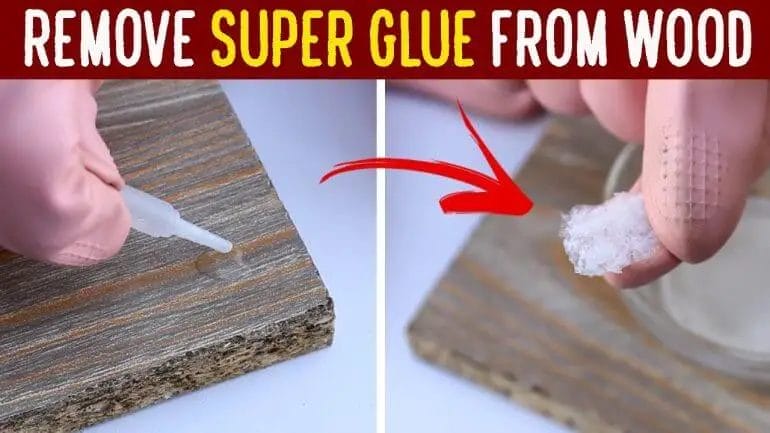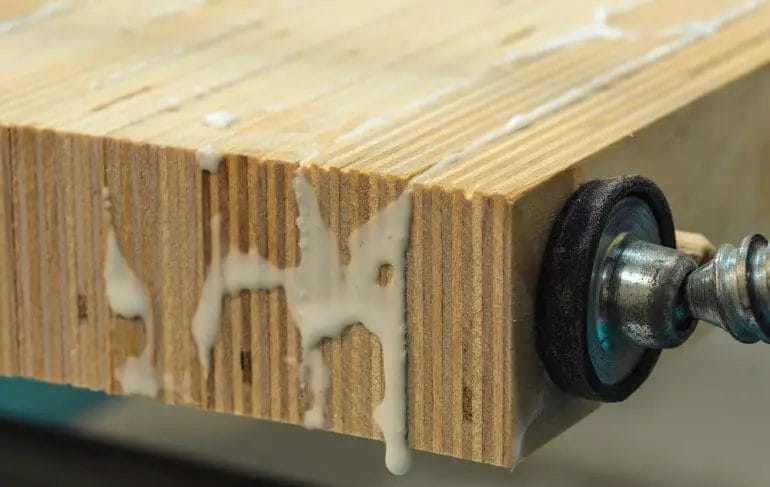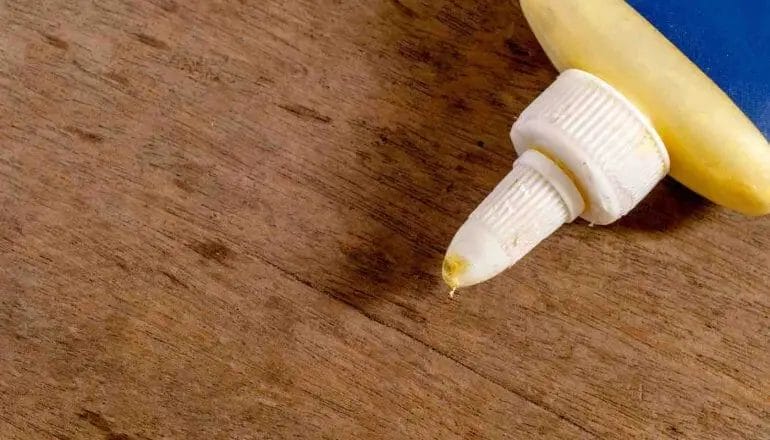Removing wood glue from wood can be a daunting task, but with the right techniques, it is possible to clean up the mess effectively. Whether you accidentally spilled glue or need to remove old dried glue, we’ve got you covered.
One of the easiest ways to remove fresh wood glue is by wiping it off with a damp cloth before it dries completely. If the glue has already dried, you can try scraping it off using a putty knife or a plastic scraper.

If scraping doesn’t work, you can use heat to soften the glue. Applying a warm iron over a cloth on top of the glue can help loosen and lift it off the wood surface.
An alternative method is to use acetone or nail polish remover. Apply a small amount on a cloth and gently rub the glue until it comes off. However, be cautious when using these substances as they may damage the wood finish.
For stubborn and older glue stains, sanding the affected area can be a viable solution. Start with a coarse sandpaper and gradually move to finer grits until the glue is removed. Remember to sand gently to avoid damaging the wood surface.
Overall, the key is to act quickly for fresh glue spills and use a combination of gentle techniques like wiping, scraping, or applying heat to remove dried glue. Always test any cleaning method on a small and inconspicuous area of the wood before proceeding to avoid any

Gentle and Safe Methods to Remove Wood Glue from Wood Surfaces
Wood glue is a commonly used adhesive in woodworking projects. While it is designed to provide a strong bond, there may come a time when you need to remove excess or dried wood glue from a wood surface. However, it is important to approach this task with care to avoid damaging the wood. In this section, we will discuss some gentle and safe methods to remove wood glue from wood surfaces.
1. Using Warm Water and Soap
One of the simplest and most gentle methods to remove wood glue is by using warm water and soap. Begin by dampening a cloth or sponge with warm water. Gently rub the cloth over the affected area, applying light pressure. This will help to soften the glue. Next, mix a small amount of liquid dish soap with warm water and apply it to the glue. Allow the soap to sit for a few minutes to further break down the adhesive. Finally, use a clean cloth or sponge to wipe away the softened glue. Repeat the process if necessary until all the glue is removed.
2. Using Vinegar
Vinegar is another effective and safe option to remove wood glue. Start by pouring some white vinegar into a spray bottle. Spray the vinegar directly onto the glue and let it sit for a few minutes. The acidity of the vinegar helps to break down the adhesive properties of the glue. After the vinegar has had time to work, use a clean cloth or sponge to wipe away the softened glue. If needed, repeat the process until the glue is completely removed.
3. Using Heat
Heat can be a useful tool for removing dried wood glue. Start by using a hairdryer on its lowest heat setting to warm the glued area. Hold the hairdryer a few inches away from the glue and move it back and forth to evenly distribute the heat. As the glue heats up, it will begin to soften. Use a plastic scraper or a credit card to gently scrape away the softened glue. Be careful not to apply too much pressure, as this could damage the wood surface. Once all the glue is removed, wipe the area clean with a damp cloth.
4. Using Citrus Oil
Citrus oil, such as orange or lemon oil, can also be effective in removing wood glue. Apply a small amount of citrus oil to a clean cloth or sponge and gently rub it over the glue. The oil helps to break down the adhesive properties of the glue, making it easier to remove. After rubbing the area for a few minutes, use a clean cloth to wipe away the softened glue. Repeat the process if necessary until the glue is completely gone.
5. Using Sandpaper
If the wood glue has dried and hardened, sanding may be necessary to remove it. Start by using a coarse-grit sandpaper to sand away the top layer of the dried glue. Be careful not to apply too much pressure, as this may damage the wood surface. Once the top layer is removed, switch to a finer-grit sandpaper and continue sanding until the remaining glue is gone. After sanding, wipe the area clean with a damp cloth to remove any residue.
It is important to note that when using any method to remove wood glue from wood surfaces, it is recommended to test the method on a small, inconspicuous area first to ensure it does not cause any damage. Additionally, always follow the manufacturer’s instructions for the specific wood glue being used.
In summary, there are several gentle and safe methods to remove wood glue from wood surfaces. These include using warm water and soap, vinegar, heat, citrus oil, and sandpaper. Depending on the type and condition of the glue, one method may be more effective than others. Always proceed with caution and test the method on a small area before applying it to the entire surface.

Expert Tips for Removing Stubborn Wood Glue Stains
Wood glue is a common adhesive used in woodworking projects. While it is great for bonding pieces of wood together, it can leave behind stubborn stains if not cleaned up properly. Fortunately, there are several expert tips and techniques you can use to effectively remove wood glue stains from your surfaces. In this section, we will discuss these tips and provide step-by-step instructions for a successful stain removal process.
Gather the necessary materials
Before you begin removing the wood glue stain, it is important to gather all the necessary materials. You will need:
- Warm water
- Mild dish soap
- White vinegar
- Denatured alcohol
- Clean cloth or sponge
- Plastic scraper or putty knife
Step 1: Scrape off the excess glue
Start the stain removal process by scraping off any excess glue from the surface using a plastic scraper or putty knife. Be careful not to damage the wood while doing this. If the glue is hardened, you can soften it by applying heat using a hairdryer. Once the excess glue is removed, proceed to the next step.
Step 2: Create a cleaning solution
Mix warm water with a few drops of mild dish soap in a bucket or bowl. This solution will help break down the glue and remove the stain effectively.
Step 3: Apply the cleaning solution
Dip a clean cloth or sponge into the cleaning solution and gently rub it onto the wood glue stain. Allow the solution to sit on the stain for a few minutes to loosen the adhesive.
Step 4: Scrub the stain
Using a soft-bristle brush or a clean cloth, gently scrub the wood glue stain in a circular motion. Be careful not to scrub too hard as it may damage the surface. Continue scrubbing until the stain starts to fade.
Step 5: Use vinegar or denatured alcohol
If the stain persists, you can try using white vinegar or denatured alcohol as a stronger cleaning agent. Apply a small amount of vinegar or alcohol onto a clean cloth and gently rub it onto the stain. Let it sit for a few minutes before scrubbing again.
Step 6: Rinse and dry
Once the wood glue stain is removed, rinse the area with clean water to remove any remaining cleaning solution. Use a dry cloth or towel to pat the surface dry.
Precautions:
When using any cleaning solution or chemical, always test it on a small, inconspicuous area of the wood first to ensure it does not cause any damage or discoloration. Additionally, avoid using abrasive materials or harsh chemicals that may harm the wood surface.
In summary, removing stubborn wood glue stains requires a combination of effective techniques and the right cleaning materials. By following these expert tips and steps, you can successfully remove wood glue stains from your surfaces without causing any damage. Remember to always handle cleaning solutions and tools with care and test them on a small area first. With patience and proper technique, your surfaces will be glue-free and looking their best.

Quick and Easy Steps to Remove Dried Wood Glue from Wood
If you have ever worked on a woodworking project, you know how frustrating it can be to deal with dried wood glue on your precious wood surfaces. Whether it’s a spilled drop of glue or excess glue that has dried up, removing it can seem like a daunting task. However, with the right tools and techniques, you can easily remove dried wood glue from wood surfaces. In this section, we will guide you through a step-by-step process to get rid of dried wood glue effectively.
Step 1: Gather the necessary supplies
Before you start the glue removal process, it’s important to gather all the necessary supplies. Here’s what you’ll need:
- Putty knife
- Scraping tool
- Sandpaper (medium and fine grit)
- Warm, soapy water
- Clean cloth or sponge
- Wood cleaner or vinegar
- Optional: Heat gun or hairdryer
Step 2: Scrape off excess glue
Using a putty knife or scraping tool, gently scrape off as much of the dried wood glue as possible. Be careful not to apply too much pressure, as you don’t want to damage the wood surface. Work in small sections and continue scraping until you have removed the majority of the dried glue.
Step 3: Apply warm, soapy water
Prepare a mixture of warm water and mild soap. Dip a clean cloth or sponge into the soapy water and wring out any excess moisture. Gently scrub the remaining dried glue with the damp cloth or sponge. The warm water and soap will help soften the glue, making it easier to remove.
Step 4: Use sandpaper to remove stubborn glue
If there are still stubborn spots of dried glue on the wood surface, you can use sandpaper to gently sand away the residue. Start with a medium-grit sandpaper and gradually switch to a finer grit to achieve a smooth finish. Remember to sand in the direction of the wood grain to avoid scratching the surface.
Step 5: Treat any remaining residue
If there are any lingering traces of glue, you can use a wood cleaner or vinegar to treat the area. Apply a small amount of the cleaner or vinegar to a clean cloth and gently rub the residue until it is dissolved or loosened. Wipe away any excess cleaner or vinegar with a damp cloth and allow the wood to dry completely.
Step 6: Optional: Apply heat
If the dried wood glue is still persistent, you can use a heat gun or a hairdryer to soften the glue. Hold the heat source a few inches away from the glue and apply heat in a back-and-forth motion. As the glue softens, gently scrape it off with the putty knife or scraping tool. Be cautious not to overheat the wood, as it can cause damage.
In summary, removing dried wood glue from wood surfaces can be accomplished with a few simple steps. By gathering the necessary supplies, scraping off excess glue, applying warm soapy water, using sandpaper for stubborn spots, treating any remaining residue, and optionally applying heat, you can restore your wood surfaces to their original condition. Remember to always take caution when working with tools and chemicals, and test any cleaning methods on a small, inconspicuous area first to ensure they won’t damage the wood.
Top DIY Solutions to Remove Wood Glue Without Damaging the Wood
If you’ve ever worked with wood, you know that using wood glue is an essential part of many projects. However, removing excess or dried wood glue can be a challenge, especially if you want to avoid damaging the wood surface. In this section, we will explore some of the top DIY solutions to remove wood glue without compromising the integrity of the wood.
1. Warm Water and Soap
One of the simplest and most effective methods to remove wood glue is by using warm water and soap. Start by mixing a small amount of dish soap with warm water in a bowl. Then, dip a sponge or cloth into the soapy water and gently scrub the affected area. The warm water will help soften the glue, making it easier to remove without harming the wood. Rinse the area with clean water and dry it thoroughly.
2. Vinegar
Vinegar is known for its versatility when it comes to cleaning, and it can also be used to remove wood glue. Mix equal parts of vinegar and water in a bowl or spray bottle. Apply the vinegar solution to the glue and let it sit for a few minutes to loosen the adhesive. Use a scraper or a cloth to gently remove the softened glue. Repeat the process if necessary and wipe the area clean with a damp cloth.
3. Acetone or Nail Polish Remover
If the wood glue has dried and hardened, acetone or nail polish remover can be effective in breaking down the adhesive. However, it’s important to note that these solvents can potentially damage certain types of wood finishes, so it’s best to test them in an inconspicuous area first. Apply a small amount of acetone or nail polish remover to a cloth and gently rub the glue until it starts to dissolve. Wipe away the residue with a clean cloth.
4. Heat and Scraper
Applying heat to the wood glue can soften it, making it easier to remove. You can use a hairdryer or a heat gun on low heat to warm the glue. Be careful not to overheat the wood, as excessive heat can cause damage. Once the glue is softened, use a scraper or a putty knife to gently scrape it off the surface. Work slowly and be cautious to avoid scratching the wood.
5. Sanding
If all else fails and the wood glue cannot be removed using the above methods, sanding may be necessary. Use fine-grit sandpaper or an orbital sander to sand away the dried glue. Start with a low grit sandpaper and gradually increase to a finer grit until the glue is completely removed. Take care not to sand too aggressively, as this may damage the wood surface. After sanding, wipe away any dust and apply a wood finish or sealer to restore the wood’s appearance.
Summary
Removing wood glue without damaging the wood can be a tricky task, but with the right DIY solutions, it can be accomplished effectively. Whether using warm water and soap, vinegar, acetone, heat and scraping, or sanding, it’s essential to approach the removal process with care and caution. Always test any solvents or methods in a small, inconspicuous area before proceeding. By following these top DIY solutions, you can successfully remove wood glue and maintain the integrity of your wood projects.
FAQs
How do I remove wood glue from wood?
To remove wood glue from wood, you can start by scraping off the excess glue with a putty knife or scraper. Then, use sandpaper to gently sand away the remaining glue. If the glue is still stubborn, you can try using a solvent like acetone or rubbing alcohol, but be sure to test it on a small, hidden area first to avoid damaging the wood.
What is the best way to clean wood furniture?
To clean wood furniture, dust it regularly with a soft cloth or microfiber duster. For deeper cleaning, mix a solution of mild dish soap and warm water, and gently scrub the surface with a soft cloth or sponge. Avoid using harsh chemicals or abrasive cleaners, as they can damage the wood. Finally, wipe away any excess moisture and let the furniture air dry.
How can I prevent wood from splitting?
To prevent wood from splitting, it’s important to properly prepare and seal the wood. Make sure to use a pilot hole when nailing or screwing into the wood to reduce the risk of splitting. Additionally, apply a wood sealer or finish to protect the wood from moisture and temperature changes, which can cause splitting. Regular maintenance, such as reapplying sealant, can also help prevent splitting.
Conclusion
In conclusion, removing wood glue from wood surfaces can be a challenging task, but with the right techniques and tools, it is achievable. Start by scraping off excess glue using a putty knife or scraper. Then, apply heat to soften the glue and carefully scrape it off. Alternatively, you can use solvents like acetone or mineral spirits to dissolve the glue. Remember to test the solvent on a small, inconspicuous area of the wood first to ensure it does not damage the finish. Lastly, sand the area to remove any residue and restore the smoothness of the wood surface. With patience and proper methods, you can effectively remove wood glue and restore your wood surfaces to their former glory.
